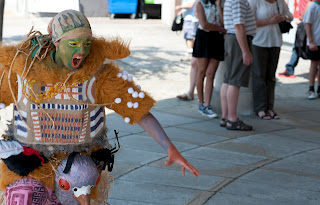"The birth of the long awaited and long needed Milton Keynes International Festival in 2010, brought a complete sea change to the new city."
How did I get here?!! Director of Milton Keynes Festival Fringe 2012. It was a bit by accident but when I looked around, all I could see were people around me who seemed to need me to fight their corner, to represent the unseen and emerging.
When I tested the temperature it seemed to me that the Arts community in Milton Keynes was fed up. Tired of the warring factions and empire builders, fed up of the silo mentality which grew up organically in a frontier town where historically, the Council had little centralised power and if you had an initiative you hung on to it like the mast of a sinking ship - every arts organisation for themselves.
 |
| Terrible Shamen, Fringe performance (photo by Legge) |
Suddenly it was time for working together, for connected programming, a time to nurture the emerging talent and bring them into the big tent to feed the old roots. The voices in the wind were calling...'collaborate or face extinction!'
Partly this was down to survival of individuals in the financial climate and a need to respond to the 2012 Cultural Olympiad projects, also a defence against the 'culture commute to London', a disease which exists in many places. But among the collective which became 'Milton Keynes, Summer of Culture' this year, there were some genuine team players who could see the bigger picture, 'for the greater good'. I wonder if this was also a symptom of a young city which is finally maturing?
 |
| Shake n Speare, one of the 6 Beach hut commissions |
I think I spent 2 months in meetings just listening to people, trying to gauge the climate. One of the first things I did was to sketch a framework together, something which all art forms could find a place within and which provided opportunities for all levels of professionalism and quality to find an appropriate artistic platform. It included open entry artist markets, open mic and busking, to commissioned installation and performance. There were also some invited artists who created links and relevance to the overarching themes. This framework provided a useful working document which was circulated for the arts community to respond and contribute to. I was also able to present this working plan to the guardians of the so called 'public spaces' otherwise known as shopping centres, the various retail consortium's which seem to have mushroomed up in the UK with no national strategy or any overall body to answer to...Always the profits over the prophets and the answer always seems to be 'it's what the people want', (just like they want trash TV and junk food)...oops I'm ranting.
 |
| Walking with Giants, community parade produced by Festive Road |
From the point of view of the International Festival and others in Milton Keynes, the growth of a healthy, thriving, locally/regional focused Festival Fringe, is of great concern, as, without one, there is always the more negative contingency of the local arts community, the 'moaners on the sidelines' who make life difficult. There is always a need for somewhere fringey, edgy and seemingly 'outsider' to focus creative energies. This allows the International Festival to focus on International horizons but it also provides a supportive space for new and experimental work to develop and get showcased.
 |
| Cycle cinema, produced by MK Independent Cinema |
The programme -all 220 different audience opportunities; including live performance, street theatre, dance, music, visual art exhibitions and participatory workshops... which were on offer over the 19 days of the Festival Fringe, can be found in the full Festival Fringe brochure which was designed by Allan Davies.
Next years MK Festival Fringe will be taking place 19 -21 July 2013 -get it in the diary now!